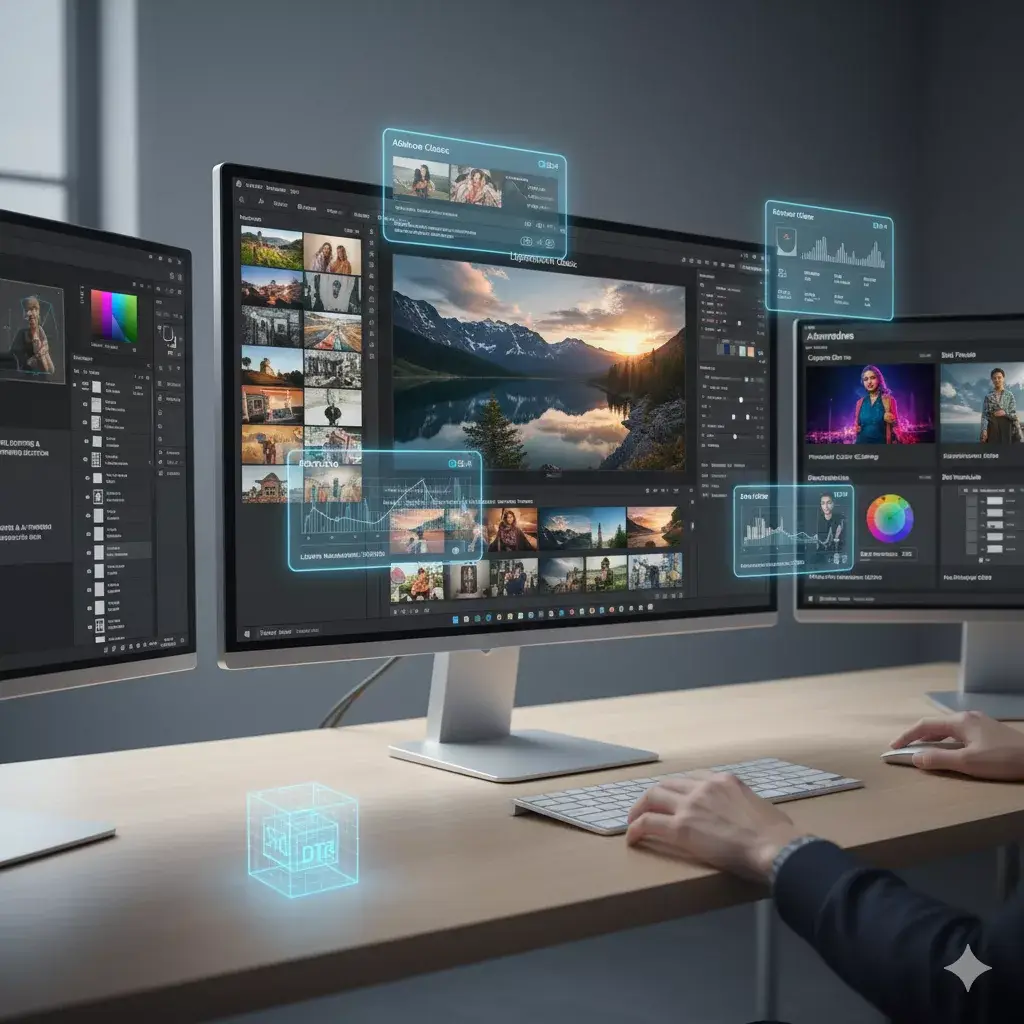
Overview: The camera captures only a fraction of the reality perceived by the human eye. The raw digital file (RAW) is a score, not a symphony. It is the editing software that transforms this inert data into a vibrant image, reflecting the photographer’s intent. In a world where post-processing is inseparable from shooting, choosing the right tool is crucial. It determines your workflow, your aesthetic, and potentially your budget. Between industry giants, ubiquitous subscriptions, and Open Source alternatives, the choice is vast and fraught with pitfalls. Let us delve into this complex ecosystem to decipher what makes software indispensable.
I. Why Photo Editing Software is Indispensable
The era when one could be content with a photo “straight out of the camera” is over, if it ever truly existed.
- Leveraging RAW: RAW files contain a wealth of information (dynamic range, colors) that JPEG compresses and discards. Editing software is the digital “darkroom” for developing this potential.
- Correcting Imperfections: Imperfect lenses (distortion, chromatic aberrations), dust on the sensor, digital noise in low light, exposure or white balance issues. The software is there to correct these technical flaws.
- Asserting Your Style: Editing is not “cheating”. It is an artistic interpretation. Adjusting colors, contrasts, light, adding an atmosphere, cropping… This is where the photographer imprints their unique vision.
- Optimizing for Distribution: Whether for the web, print, social media, or an exhibition, each medium has its requirements. The software allows for adapting and exporting the image in the ideal format and specifications.
II. Market Leaders: The Adobe Duopoly
It is impossible to discuss photo editing without starting with Adobe, which dominates the professional market with two pillars:
A. Adobe Lightroom Classic (and its Cloud variations)
- Philosophy: Cataloger, RAW developer, and non-destructive editing.
- Advantages:
- Library Management (DAM): Powerful organization tool (keywords, collections, notes, flags) indispensable for managing thousands of images.
- Comprehensive RAW Development: An exhaustive suite of tools (exposure, color, HSL, curves, lens corrections) for global and local image processing.
- Non-Destructive: All modifications are saved separately and can be undone at any time without altering the original.
- Integrated Workflow: Import, sorting, development, export, slideshow, photo book, print… everything in one place.
- Cloud Synchronization (Lightroom “cloud”): Allows editing on mobile or tablet and syncing with the desktop (but less powerful than Classic).
- Community and Resources: Thousands of tutorials, presets, plugins available.
- Weaknesses:
- Performance: Can be resource-intensive, especially with massive catalogs or large RAW files.
- Advanced Editing: Limited for image manipulation (composites, complex masks, removal of major elements). Requires Photoshop.
- Subscription: The subscription model (Creative Cloud) is a recurring cost that can be significant over time.
- Complexity: Medium. The interface is logical and module-based. Mastering the catalog takes time.
- Actual Cost: Photography Plan (Lightroom Classic + Photoshop): approximately €12/month. Cost over 5 years: €720.
B. Adobe Photoshop
- Philosophy: The image manipulation tool par excellence. The pixel’s “Swiss Army knife”.
- Advantages:
- Precision Editing: Layer systems, advanced masks, blending modes, sophisticated selection tools.
- Montage and Compositing: Creation of composite images from multiple sources.
- Graphic Design: Digital painting, interface design, illustration.
- AI Features (Adobe Sensei): Automatic selection, object removal, neural filters… increasingly powerful.
- Extreme Versatility: Used by photographers, designers, illustrators, 3D artists.
- Weaknesses:
- Non-Destructive “by default”: Less so than Lightroom. Requires rigor with adjustment layers, smart objects, and masks.
- Library Management: Almost non-existent. Photoshop is not a cataloger.
- Learning Curve: Very High. Mastering Photoshop takes years.
- Subscription: Same as Lightroom.
- Complexity: Very High. Most powerful tool, but also the most complex.
- Actual Cost: Included in the Photography Plan (€12/month).
Necessity of the Adobe Duopoly: For the professional who needs to manage thousands of photos and perform advanced edits, the Lightroom Classic + Photoshop combination remains the gold standard. Lightroom handles volume, Photoshop handles precision and limitless creativity. It is a proven workflow.
III. Credible Alternatives to the Leaders
The market is not a monopoly. Robust alternatives offer different philosophies, often at a lower initial cost.
A. Capture One Pro
- Philosophy: High-end RAW developer, renowned for its superior image quality.
- Advantages:
- RAW Quality: Many professionals consider it superior to Lightroom for color rendering, noise, and sharpness, especially with certain camera bodies (Fuji, Sony).
- Advanced Color Management: Precise and intuitive color tools, unique color editor.
- Session Management: Ideal for studio shooting (tethering) with quick deliverables.
- Local Adjustments: Adjustment layer system more powerful than Lightroom, approaching Photoshop in its flexibility.
- Customizable Interface: Tools can be organized as desired.
- Weaknesses:
- Library Management: Less intuitive and slower than Lightroom for large catalogs.
- Complexity: More demanding to learn than Lightroom, especially layers and sessions.
- Cost: More expensive than Adobe over time if annual updates are made.
- No “Pixel Perfect” Editing Software: Still requires Photoshop for fine manipulation.
- Complexity: High.
- Actual Cost: Perpetual License: approximately €350. Annual Subscription: approximately €200. Major updates are paid for with the perpetual license.
B. DxO PhotoLab
- Philosophy: RAW development focused on optical correction and denoising, with unique technologies.
- Advantages:
- Optical Correction (DxO Optics Modules): The best on the market. Each lens is precisely measured.
- Revolutionary Denoising (DeepPRIME / DeepPRIME XD): Uses AI to reduce noise while preserving details, transforming photos taken at very high ISOs.
- U Point (Nik Collection): Local point selection technology, very intuitive and effective.
- Excellent for sharpness and micro-contrast.
- Weaknesses:
- Library Management: Weak. It is a “developer,” not a cataloger.
- Advanced Editing: Limited. Less creative control over colors than Capture One or Lightroom. No pixel editing.
- Non-Destructive: Yes.
- Complexity: Medium. The tools are clear, but one must understand the module-based approach.
- Actual Cost: Perpetual License: approximately €130 (Essential) to €220 (Elite) per version. Annual updates are paid.
C. Affinity Photo
- Philosophy: The “Photoshop killer” alternative with a one-time purchase.
- Advantages:
- Features Equivalent to Photoshop: Layers, masks, selection tools, filters, precision editing. Very powerful.
- One-Time Purchase: No subscription. A low initial cost.
- Performance: Fast and fluid.
- Compatibility: Opens and edits PSD (Photoshop) files.
- Modern Interface: Intuitive for those familiar with Photoshop concepts.
- Weaknesses:
- Library Management: None. Requires other software for cataloging (Bridge, or a dedicated DAM).
- RAW Development: Module included, but less powerful and comprehensive than Lightroom/Capture One/DxO.
- Learning Curve: High, like Photoshop.
- Complexity: Very High.
- Actual Cost: One-time purchase: approximately €70. (Version 2.0). Major updates are paid (every X years).
D. GIMP (GNU Image Manipulation Program)
- Philosophy: The free Open Source alternative to Photoshop.
- Advantages:
- FREE: Zero cost.
- Powerful: Manages layers, masks, selections, many filters.
- Community: Large community of developers and users.
- Weaknesses:
- Interface: Less ergonomic and modern than Photoshop/Affinity. Can be off-putting.
- RAW Development: Requires an external plugin (RawTherapee or Darktable).
- Compatibility: PSD management sometimes limited.
- Learning Curve: Very High and sometimes frustrating.
- Complexity: Very High.
- Actual Cost: €0.
IV. My Favorite Software and Why
My personal choice, and the one I consider most effective for the majority of professional photographers, remains the Adobe Lightroom Classic + Photoshop duo.
Why?
- The Unrivaled Workflow: It’s about fluidity and integration. From the moment I import my 2000 wedding photos to the final editing of 20 of them in Photoshop, everything happens seamlessly. The catalog is central, the tools are there.
- The Power of Photoshop: No alternative can match the depth and versatility of Photoshop for precision editing, compositing, object removal, or advanced techniques. It is the tool that never tells me “no”.
- The Ecosystem and Community: I benefit from thousands of presets, plugins, actions, and help available everywhere online. Every problem has already been solved by someone.
- AI Features: Adobe Sensei improves with each update, making complex tasks incredibly simple and fast (sky selection, subject selection, element removal).
- Constant Updates: Adobe constantly innovates, adapting to new camera bodies, new trends, and new technologies (such as HDR for the web).
Yes, the subscription is a recurring cost. But it is the price of reliability, constant innovation, and the certainty that I have the best tools on the market for my professional activity. It is a business cost that I consider indispensable.
V. Usage and Configuration Complexity
- Adobe (Lightroom / Photoshop):
- Usage: Lightroom Medium, Photoshop Very High.
- Configuration: Simple. Easy installation, automatic catalog management. Performance optimization on powerful machines.
- Capture One Pro:
- Usage: High. Different logic from Lightroom (sessions vs. catalogs).
- Configuration: Simple, but more options for hardware acceleration.
- DxO PhotoLab:
- Usage: Medium. Clear interface, but specific tools.
- Configuration: Simple. Automatic optical module download.
- Affinity Photo:
- Usage: Very High.
- Configuration: Simple.
- GIMP:
- Usage: Very High and sometimes archaic.
- Configuration: More complex for plugins and integration.
VI. Power Consumption & Impact
There is no major difference in power consumption between the software itself. Rather, it is the power of your computer that dictates consumption. Software that intensely uses the processor and graphics card (like Photoshop for large files) will cause your machine to consume more energy.
However, developers are increasingly optimizing their software to utilize multiple cores and AI-dedicated chips (GPUs), which, paradoxically, can accelerate processing while reducing the duration of intensive use.
Conclusion
The choice of photo editing software reflects your photographic practice and your expectations.
- If your work relies on quantity, organization, and versatility (from RAW development to complex compositing), the Adobe Lightroom Classic + Photoshop tandem remains the benchmark. The subscription cost is an investment in your primary work tool.
- If RAW development quality and color precision are your absolute priority, and you can compensate for organization with another tool, Capture One Pro is an excellent alternative.
- If optical correction, denoising, and the simplicity of local adjustments are essential, especially in low light, DxO PhotoLab is unparalleled.
- If you are looking for a Photoshop replacement without a subscription, with almost identical functions, Affinity Photo is a powerful and economical choice.
- For a zero budget, GIMP remains an option for the most patient and technically inclined.
Ultimately, the best software is the one you master best and that precisely meets your needs. Test trial versions, evaluate your workflow and budget, then invest in the tool that will allow you to transform your raw images into true works of art.
This post is also available in:
French
